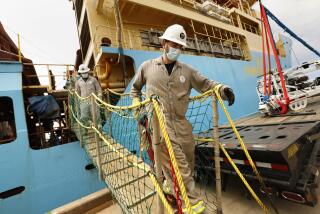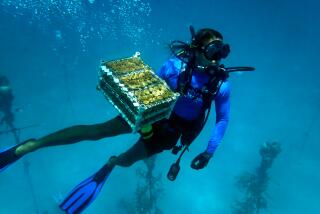Chemicals Making Dent in Seaweed Infestation
- Share via
CARLSBAD, Calif. — A chemical assault on an invasive seaweed that threatened marine life along the coast appears promising, marine researchers said.
An initial treatment of concentrated chlorine has killed patches of the plant and much of its roots. The plant has been flourishing in a half-acre of the Agua Hedionda Lagoon, 20 miles north of San Diego.
Scientists estimate it will take at least three months to completely rid the lagoon of the plant.
The algae, known as Caulerpa taxifolia, has already caused extensive damage in the Mediterranean Sea and could threaten coastal habitats statewide if untreated.
The seaweed smothers eelgrass and other aquatic plants that fish, lobster, clams and other sea creatures feed off and live around.
Divers began treating isolated patches of the plant last week by dropping chlorine tablets, similar to those used in swimming pools.
The success of those tablets has led to the use of liquid chlorine, which is now being released to cover a larger area, officials said.
Scientists suspect the algae got into the lagoon years ago when someone poured an aquarium containing the plant down a storm drain.
More to Read
Sign up for Essential California
The most important California stories and recommendations in your inbox every morning.
You may occasionally receive promotional content from the Los Angeles Times.










